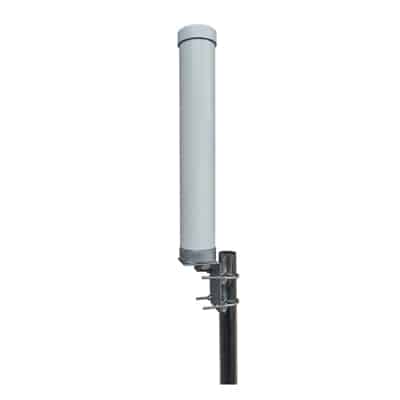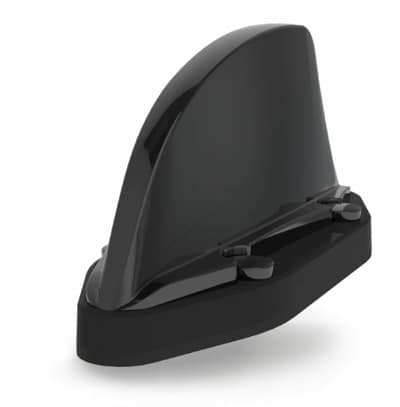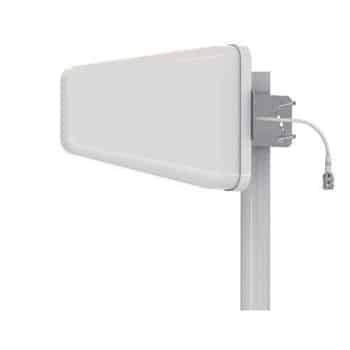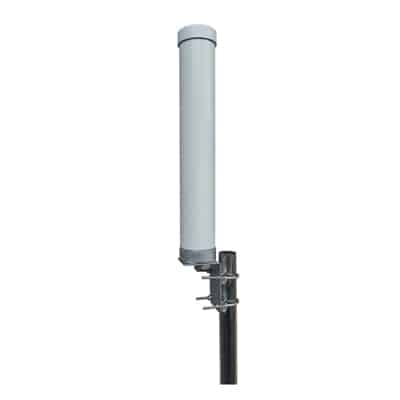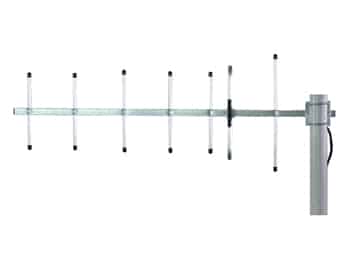
Die Wahl zwischen externen und internen 4G-Antennen hat Auswirkungen auf die Leistung und Funktionalität unserer drahtlosen Geräte. Ohne eine integrierte Antenne können wir ein Gerät nicht als drahtlos betrachten, was die Frage aufwirft: "Warum?" Die Antwort ist einfach. Ohne Antenne kann das Gerät nicht kommunieren. Diese Antennen können sich entweder innerhalb oder außerhalb des Geräts befinden. Die Auswahl der richtigen Antenne kann ein schwieriger Prozess sein.
Dieser Artikel bietet einen Überblick über beide Antennen und geht dabei auf ihr Design, die Signalempfangsqualität, den Installationsprozess, die Leistung in verschiedenen Umgebungen, Anwendungsfälle und die Wartung ein. Diese Faktoren sind entscheidend für die Auswahl einer 4G-Antenne.
Inhaltsübersicht
Umschalten aufGrundlegende Unterschiede
Der Hauptunterschied zwischen internen Antennen und externen Antennen ist die Platzierung. Interne 4G-Antennen befinden sich im Inneren des Geräts und sind in der Regel für den Nutzer nicht sichtbar. Die interne Antenne fügt sich nahtlos in das Gerät ein, was zu einem einheitlichen Design führt. Dies führt zu einem kompakten und kleineren Erscheinungsbild des Geräts. Allerdings kann der Signalempfang dadurch leicht beeinträchtigt werden.
Bei der externen 4G-Antenne hingegen sind das Gerät und die Antenne voneinander getrennt. Das Gerät besteht aus dem Host, der Signalleitung und der Stromleitung. Da die Signalleitung extern ist, kann sie in der Nähe des peripheren Bereichs platziert werden, was zu einer Verbesserung der Signalstärke und -stabilität beiträgt. Bei der Auswahl einer Antennenlösung für einen bestimmten Zweck sollten wir jedoch das Design, die Größe, die Kosten und die Einfachheit der Installation berücksichtigen.
Design und Ästhetik
Das Design der internen Antennen trägt zu einem schlanken Erscheinungsbild bei und spart Platz. Dies ist bei mehreren tragbaren Geräten, einschließlich Smartphones und Laptops, wichtig. Abgesehen davon bieten interne Antennen einen relativ hohen Gewinn, fortschrittliche Verarbeitungsmöglichkeiten, gleichbleibende Produktqualität und ein elegantes Aussehen des Geräts. Da die interne Antenne im Inneren des Geräts installiert ist, verfügt sie über eine gute mechanische Festigkeit. Die Vorteile interner Antennen sind hervorragend, aber sie können an abgelegenen Orten möglicherweise nicht genügend Empfindlichkeit bieten. Hier kommen dann die externen Antennen ins Spiel.
Externe Antennen spielen eine entscheidende Rolle bei der Verbesserung der Leistung von drahtlosen Netzen, indem sie die Signalstärke verbessern und die Abdeckungsbereiche erweitern. Aufgrund ihres Designs sind sie im Allgemeinen nicht für kleine tragbare Geräte geeignet. Sie eignen sich gut für stationäre Geräte, einschließlich entfernter Sensoren, Router und Modems. Externe Antennen sind jedoch anfälliger für physische Schäden. Diese Antennen sind sperrig und fügen sich möglicherweise nicht gut in die Umgebung ein. Für die Einrichtung dieser externen Antennen sind unter Umständen zusätzliche Werkzeuge und Kenntnisse erforderlich.
Qualität des Signalempfangs
Die Signalempfangsqualität ist ein entscheidender Faktor bei der Wahl zwischen internen und externen 4G-Antennen. Bei der Bewertung der Empfangsqualität kommen zwei Hauptfaktoren ins Spiel. Der erste Faktor ist die Signalstärke. Externe Antennen bieten im Vergleich zu internen Antennen eine bessere Signalstärke.
Der zweite Punkt, der sich auf die Qualität des Signalempfangs auswirkt, ist der Standort oder die Platzierung der Antenne. Externe Antennen können an verschiedenen Orten installiert werden. Externe Antennen werden in der Regel an Orten mit minimalen Hindernissen installiert, so dass sie eine bessere Signalqualität liefern können. Interne Antennen hingegen sind in die Geräte integriert, so dass sie eine vergleichsweise geringere Signalqualität liefern.
Installationsprozess
Bei der Installation von 4G-Antennen ist es wichtig, die Unterschiede zwischen der Installation interner und externer Antennen zu verstehen und dabei den Aufwand und die erforderlichen Schritte sowie mögliche Probleme zu berücksichtigen.
Interne 4G-Antennen sind hauptsächlich in elektronische Geräte wie Smartphones, Tablets und eingebettete Systeme vorintegriert. Daher müssen die Endnutzer den Installationsprozess nicht durchführen, da die Antenne vom Gerätehersteller untergebracht und feinabgestimmt wird. Das bedeutet, dass interne Antennen ein unkompliziertes Erlebnis bieten, ohne dass der Nutzer eine weitere Einrichtung vornehmen muss.
Die Installation von 4G-Außenantennen ist hingegen mit mehreren Schritten und Herausforderungen verbunden. Die folgenden Schritte skizzieren den Prozess im Detail,
- Standortbestimmung: Ermitteln Sie den besten Standort für die Antenne, indem Sie die Richtung des nächstgelegenen Mobilfunkmastes ablesen. Tools wie Cell Mapper können verwendet werden, um die nächstgelegenen Mobilfunkmasten zu ermitteln, was für die optimale Aufstellung der Richtantennen wichtig ist.
- Montage der Antenne: Befestigen Sie die Antenne an einem Ort, an dem es keine Hindernisse in der Umgebung gibt, z. B. im Freien, und idealerweise in einiger Höhe über Hindernissen, um Störungen zu vermeiden, damit das Signal empfangen werden kann. Eine ordnungsgemäße Montage mit geeigneten Halterungen gewährleistet einen sicheren und stabilen Betrieb der Antenne.
- Ausrichten: Richten Sie die Antenne generell in die Richtung des ermittelten Mobilfunkmastes aus. Die Beibehaltung einer guten Ausrichtung ist wichtig, um eine bessere Leistung zu erzielen. Einige Tools zur Überwachung der Signalstärke können verwendet werden, um die Ausrichtung zu verbessern.
- Koaxial-Verbindungen: Es ist immer ratsam, die Verbindungen mit einem hochwertigen Kabel zu verlegen. Um Signalverluste zu vermeiden, ist es wichtig, die Kabellänge kurz zu halten. Außerdem muss sichergestellt werden, dass alle Verbindungen wetterfest sind, wenn sie nach außen führen.
Die Position oder Richtung der Antenne kann nach Abschluss der Geschwindigkeitskontrollen geändert werden, und die Signalstärke wird auf Veränderungen oder Verbesserungen hin beobachtet.
Herausforderungen:
- Technische Kenntnisse: Bei der Installation kann ein grundlegendes Verständnis der Signalfrequenzprinzipien erforderlich sein.
- Physikalische Beschränkungen: Die verfügbaren Installationsoptionen können begrenzt sein, da nicht alle Standorte Zugang zu einer geeigneten Montage haben.
- Witterungsbeständigkeit: Um Langlebigkeit und Funktionsfähigkeit zu gewährleisten, müssen Außenantennen und Kabel abgedichtet werden.
Die externen Antennen erfordern also einen praktischen Ansatz, während die internen Antennen leicht integriert werden können, ohne dass eine Installation erforderlich ist.
Mobilität und Tragbarkeit
Wie bereits erwähnt, sind die internen Antennen in die Geräte integriert, wodurch ein schlankes und stromlinienförmiges Design erreicht werden kann. Diese Integrationsfunktion ist bei tragbaren Geräten wie Smartphones, Tablets und Laptops von Vorteil, da das schlanke Erscheinungsbild erhalten bleiben muss. Das Fehlen äußerer hervorstehender Teile verringert auch die Gefahr von Brüchen bei der Handhabung.
Bei externen Antennen gibt es einige Mobilitätseinschränkungen. Da die Antenne extern auf dem Gerät installiert ist, wird sie größer und benötigt zusätzliche Montagekomponenten. Externe Antennen sind auch ungeeignet für Geräte, die für den mobilen Einsatz gebaut wurden, da die richtige Positionierung und Platzierung für eine optimale Leistung die Mobilität einschränken kann.
Leistung in städtischen Gebieten
Aufgrund der Nähe zahlreicher Mobilfunktürme sind die Mobilfunksignale in städtischen Gebieten sehr stark und interne Antennen reichen für alle praktischen Zwecke aus. In städtischen Gebieten gibt es mehrere Schwierigkeiten, da bauliche Hindernisse, Mehrweginterferenzen und Signalreflexionen die Signalqualität häufig beeinträchtigen. Außerdem schränkt die feste Position der internen Antennen in einem Gerät die Einstellmöglichkeiten für einen optimalen Signalempfang ein. Dies kann zu einer schlechten Leistung in städtischen Gebieten führen.
Lassen Sie uns nun die Vorteile von externen Antennen in dicht besiedelten Gebieten untersuchen,
- Verbesserter Signalempfang: Platzieren Sie die externen Antennen an strategisch günstigen Stellen, um Hindernisse und Interferenzen zu vermeiden und stärkere Signale zu empfangen. Durch die Anbringung einer externen Antenne kann der Benutzer das Problem der Signalverschlechterung in Innenräumen aufgrund von Baumaterialien und Reflexionen beseitigen.
- Flexibilität bei der Platzierung: Sie können mit externen Antennen strategischer positioniert werden, um die Sichtverbindung zu Mobilfunkmasten zu verbessern, was zu einem zuverlässigeren Signal führt. Aufgrund der Behinderung durch dichte Bebauung ist dieser Vorteil in städtischen Gebieten von entscheidender Bedeutung.
- Bessere Leistung: Externe Antennen haben in der Regel einen höheren Gewinn als interne Antennen, was einen besseren Empfang und eine bessere Übertragung von Signalen in Gebieten mit hoher Nutzerdichte und Störungen ermöglicht. Dies führt zu einer stärkeren Konnektivität und schnelleren Datenübertragungsraten in städtischen Gebieten.
Da interne Antennen bequem sind und in vielen städtischen Gebieten eine ausreichende Abdeckung bieten, sind externe Antennen viel effektiver bei der Überwindung von Hindernissen in stark bevölkerten Gebieten. Um eine starke 4G-Konnektivität in komplexen städtischen Umgebungen zu gewährleisten, werden sie aufgrund ihrer überragenden Flexibilität bei der Platzierung und ihrer verbesserten Signalempfangsfähigkeiten sehr empfohlen1TP15.
Leistung in ländlichen Gebieten
Im Allgemeinen sind interne Antennen für Situationen gedacht, in denen die Signalquellen stark und in der Nähe sind. In ländlichen Gebieten ist die Entfernung zu Mobilfunkmasten in der Regel gleichbedeutend mit viel schwächeren Signalen. Aufgrund des begrenzten Gewinns und der festen Positionierung der internen Antennen in den Geräten können diese weit entfernten Signale kaum effektiv erfasst werden. Außerdem werden die Signale durch Hügel, Bäume und Gebäude weiter abgeschwächt, was den Empfang für interne Antennen noch schwieriger macht.
Die Installation einer Außenantenne in größerer Höhe, z. B. auf dem Dach, führt zu einer stärkeren Signalstärke. Dies ist auf einige Hindernisse und schwache Signale zurückzuführen, die innerhalb des Hauses reflektiert werden. Außerdem sind die meisten Außenantennen für einen höheren Gewinn ausgelegt, so dass sie auch schwache Signale von weit entfernten Masten erfassen können. Externe Antennen können auf bestimmte Mobilfunkmasten ausgerichtet werden, um den Empfang in Gebieten zu verbessern, in denen die Masten weit voneinander entfernt sind. Dadurch wird die Signalqualität in ländlichen Gebieten verbessert. Diese Richtwirkung ist für eine zuverlässige Konnektivität in ländlichen Gebieten von großer Bedeutung.
Langlebigkeit und Wetterbeständigkeit
Interne Antennen sind, obwohl sie im Inneren des Geräts vergraben sind, in der Regel besser gegen physische Schäden geschützt, da sie gegen die meisten äußeren Stöße abgefedert sind. In Wirklichkeit hängt ihre Haltbarkeit von den Konstruktionsmaterialien des Geräts ab. Sie sind zwar weniger anfällig für Brüche, aber ihre Signalleistung nimmt mit der Zeit durch Feuchtigkeit, Temperaturschwankungen und elektromagnetische Störungen im Gerät ab. Interne Antennen sind in der Regel so ausgelegt, dass sie normalen Betriebsbedingungen standhalten, können aber unter extremen Umweltbedingungen, insbesondere bei Überhitzung oder schlechter Abschirmung, an Leistung verlieren.
Externe Antennen sind auch Temperaturschwankungen, Regen, Schnee, Staub und Wind stärker ausgesetzt. Im Laufe der Zeit können all diese Faktoren zu Korrosion, Materialermüdung und allgemeinem Verschleiß führen, was die Leistung beeinträchtigt. Die UV-Strahlung des Sonnenlichts kann Kunststoffteile angreifen, während extreme Temperaturen die strukturelle Integrität der Materialien beeinträchtigen können. Die meisten im Freien installierten Antennen sind mit Gehäusen ausgestattet und daher einigermaßen widerstandsfähig.
Anwendungsfälle
Interne Antennen eignen sich am besten für ästhetische Bedingungen und bei beengten Platzverhältnissen. Sie eignen sich hervorragend für Anwendungen, bei denen der Platz begrenzt ist und ein Hervorstehen nach außen nicht erwünscht ist. In-Home-Wi-Fi-Setups und interne Antennen auf Geräten können ausreichend sein, solange der Bereich nicht sehr groß ist und die physischen Barrieren minimal sind. Aufgrund der Rundstrahlcharakteristik interner Antennen eignen sie sich für eine gleichmäßige Signalverteilung und sind daher für Standardanwendungen in Wohngebieten geeignet. Interne Antennen sind auch in der Unterhaltungselektronik sehr beliebt, z. B. bei Tablets, Smartphones und IoT-Geräten, wo Eleganz eine Notwendigkeit ist.
Schauen wir uns nun die idealen Bedingungen für externe 4G-Antennen an. Externe Antennen können eingesetzt werden, wenn ein größerer Bedarf an Signalstärke und Abdeckung in einem Gebiet besteht, insbesondere unter schwierigen Bedingungen. Große Freiflächen wie Lagerhallen, Hörsäle und Stadien können durch die Installation externer Antennen an geeigneten Stellen einen besseren Service und eine bessere Abdeckung erhalten. Sie sind auch in Branchen nützlich, in denen die Baumaterialien die Signalausbreitung stören können. Die Flexibilität, externe Antennen an optimalen Standorten zu platzieren, trägt dazu bei, solche Probleme zu entschärfen. Beim Einsatz im Freien oder in Gebieten mit hoher Nutzerdichte können durch externe Antennen mit bestimmten Strahlungsmustern, die eine nahtlose Konnektivität gewährleisten, auch gezielte Signale an den gewünschten Stellen bereitgestellt werden.
Reparatur und Wartung
Interne Antennen sind in der Regel wartungsfrei, da sie geschützt im Gerät untergebracht sind. Da interne Antennen vor Staub, Wasser oder physischen Schäden geschützt sind, müssen sie nur gelegentlich gewartet werden. Das größte Problem bei der Wartung ist die ordnungsgemäße Funktion des Geräts selbst. Zum Beispiel können Firmware- oder Software-Updates regelmäßig durchgeführt werden, um den Signalempfang zu optimieren. Die internen Antennen sind jedoch nicht leicht zugänglich und lassen sich im Falle eines Ausfalls nicht einfach austauschen, so dass in solchen Fällen ein Austausch des Geräts die einzige Lösung sein kann. Diese Haltbarkeit und der wartungsfreie Betrieb machen interne Antennen zu einer möglichen Option für Verbraucherprodukte.
Externe Antennen sind anfällig für Abnutzung, da sie Umwelteinflüssen wie Wind, Regen und Temperaturschwankungen ausgesetzt sind. Sie sollten regelmäßig gereinigt und überprüft werden, um eine Beeinträchtigung der Signale durch Schmutz oder Korrosion zu vermeiden. Die Reparatur von Außenantennen umfasst in der Regel die Überprüfung und den Austausch von beschädigten Kabeln, Steckern oder Antennen. Eine qualitativ hochwertige Montage und geeignete wetterfeste Materialien können die Lebensdauer von Außenantennen verlängern. Externe Antennen müssen nach der Reparatur auch neu kalibriert werden, damit sie optimal funktionieren. Externe Antennen lassen sich im Falle einer schweren Beschädigung leichter austauschen als interne Antennen und sind daher im Hinblick auf die Wartung günstiger.
Schlussfolgerung
Kurz gesagt, sowohl interne als auch externe Antennen haben bestimmte Vorteile und Einschränkungen, die auf den Anforderungen des Geräts, der Umgebung und des Nutzungsszenarios basieren. Interne Antennen bieten eine geringe Größe, Robustheit und einfache Integration, die am besten für Unterhaltungselektronik in allgemeinen Umgebungen geeignet ist. Ihre Leistung kann jedoch in rauen Umgebungen beeinträchtigt werden, insbesondere in städtischen oder verbauten Umgebungen. Externe Antennen sind jedoch überlegen, wenn es darum geht, eine stärkere Signalstärke, Flexibilität und den Betrieb in extremen Umgebungen und sehr dichten städtischen Umgebungen zu gewährleisten. Um die richtige Antennenlösung zu finden, ist es von unschätzbarem Wert, die besonderen Anforderungen der Anwendung und die Umgebungsfaktoren zu kennen. Beide Antennenlösungen spielen eine entscheidende Rolle bei der Bereitstellung einer stabilen drahtlosen Verbindung für eine Vielzahl von Geräten und Anwendungen.

